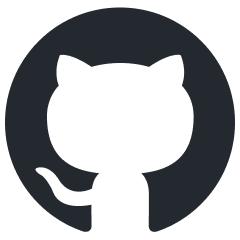
llm-twin-course
🤖 𝗟𝗲𝗮𝗿𝗻 for 𝗳𝗿𝗲𝗲 how to 𝗯𝘂𝗶𝗹𝗱 an end-to-end 𝗽𝗿𝗼𝗱𝘂𝗰𝘁𝗶𝗼𝗻-𝗿𝗲𝗮𝗱𝘆 𝗟𝗟𝗠 & 𝗥𝗔𝗚 𝘀𝘆𝘀𝘁𝗲𝗺 using 𝗟𝗟𝗠𝗢𝗽𝘀 best practices: ~ 𝘴𝘰𝘶𝘳𝘤𝘦 𝘤𝘰𝘥𝘦 + 12 𝘩𝘢𝘯𝘥𝘴-𝘰𝘯 𝘭𝘦𝘴𝘴𝘰𝘯𝘴
Stars: 3118
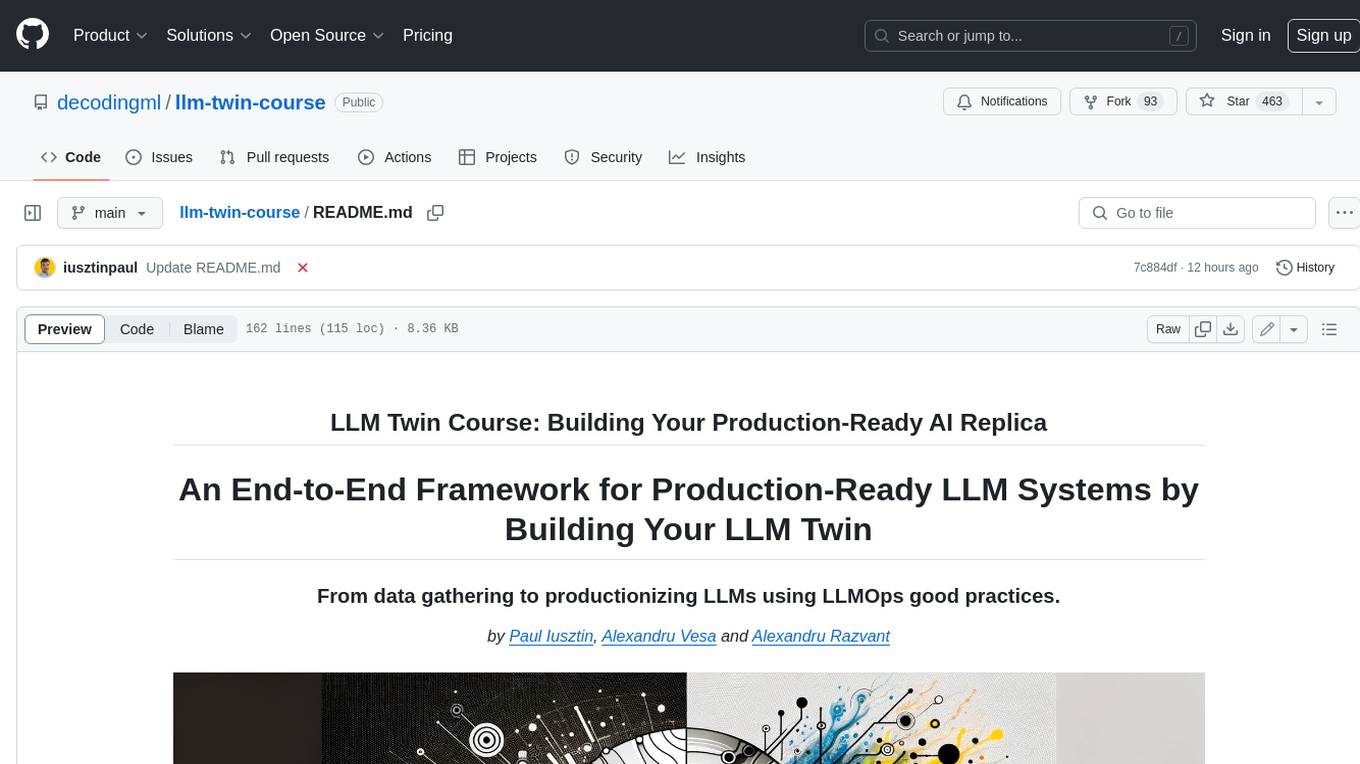
The LLM Twin Course is a free, end-to-end framework for building production-ready LLM systems. It teaches you how to design, train, and deploy a production-ready LLM twin of yourself powered by LLMs, vector DBs, and LLMOps good practices. The course is split into 11 hands-on written lessons and the open-source code you can access on GitHub. You can read everything and try out the code at your own pace.
README:
By finishing the "LLM Twin: Building Your Production-Ready AI Replica" free course, you will learn how to design, train, and deploy a production-ready LLM twin of yourself powered by LLMs, vector DBs, and LLMOps good practices.
No more isolated scripts or Notebooks! Learn production ML by building and deploying an end-to-end production-grade LLM system.
You will learn how to architect and build a real-world LLM system from start to finish - from data collection to deployment.
You will also learn to leverage MLOps best practices, such as experiment trackers, model registries, prompt monitoring, and versioning.
The end goal? Build and deploy your own LLM twin.
What is an LLM Twin? It is an AI character that learns to write like somebody by incorporating its style and personality into an LLM.
- Crawl your digital data from various social media platforms, such as Medium, Substack and GitHub.
- Clean, normalize and load the data to a Mongo NoSQL DB through a series of ETL pipelines.
- Send database changes to a RabbitMQ queue using the CDC pattern.
- Learn to package the crawlers as AWS Lambda functions.
- Consume messages in real-time from a queue through a Bytewax streaming pipeline.
- Every message will be cleaned, chunked, embedded and loaded into a Qdrant vector DB.
- In the bonus series, we refactor the cleaning, chunking, and embedding logic using Superlinked, a specialized vector compute engine. We will also load and index the vectors to a Redis vector DB.
- Create a custom instruction dataset based on your custom digital data to do SFT.
- Fine-tune an LLM using LoRA or QLoRA.
- Use Comet ML's experiment tracker to monitor the experiments.
- Evaluate the LLM using Opik
- Save and version the best model to the Hugging Face model registry.
- Run and automate the training pipeline using AWS SageMaker.
- Load the fine-tuned LLM from the Hugging Face model registry.
- Deploy the LLM as a scalable REST API using AWS SageMaker inference endpoints.
- Enhance the prompts using advanced RAG techniques.
- Monitor the prompts and LLM generated results using Opik
- In the bonus series, we refactor the advanced RAG layer to write more optimal queries using Superlinked.
- Wrap up everything with a Gradio UI (as seen below) where you can start playing around with the LLM Twin to generate content that follows your writing style.
Along the 4 microservices, you will learn to integrate 4 serverless tools:
- Comet ML as your experiment tracker and data registry;
- Qdrant as your vector DB;
- AWS SageMaker as your ML infrastructure;
- Opik as your prompt evaluation and monitoring tool.
This course is ideal for:
- ML/AI engineers who want to learn to engineer production-ready LLM & RAG systems using LLMOps good principles
- Data Engineers, Data Scientists, and Software Engineers wanting to understand the engineering behind LLM & RAG systems
Note: This course focuses on engineering practices and end-to-end system implementation rather than theoretical model optimization or research.
| Category | Requirements |
|---|---|
| Skills | Basic understanding of Python and Machine Learning |
| Hardware | Any modern laptop/workstation will do the job, as the LLM fine-tuning and inference will be done on AWS SageMaker. |
| Level | Intermediate |
All tools used throughout the course will stick to their free tier, except:
- OpenAI's API, which will cost ~$1
- AWS for fine-tuning and inference, which will cost < $10 depending on how much you play around with our scripts and your region.
As an open-source course, you don't have to enroll. Everything is self-paced, free of charge and with its resources freely accessible as follows:
- code: this GitHub repository
- articles: Decoding ML
The course contains 10 hands-on written lessons and the open-source code you can access on GitHub, showing how to build an end-to-end LLM system.
Also, it includes 2 bonus lessons on how to improve the RAG system.
You can read everything at your own pace.
This self-paced course consists of 12 comprehensive lessons covering theory, system design, and hands-on implementation.
Our recommendation for each module:
- Read the article
- Run the code to replicate our results
- Go deeper into the code by reading the
srcPython modules
[!NOTE] Check the INSTALL_AND_USAGE doc for a step-by-step installation and usage guide.
| Lesson | Article | Category | Description | Source Code |
|---|---|---|---|---|
| 1 | An End-to-End Framework for Production-Ready LLM Systems | System Design | Learn the overall architecture and design principles of production LLM systems. | No code |
| 2 | Data Crawling | Data Engineering | Learn to crawl and process social media content for LLM training. | src/data_crawling |
| 3 | CDC Magic | Data Engineering | Learn to implement Change Data Capture (CDC) for syncing two data sources. | src/data_cdc |
| 4 | Feature Streaming Pipelines | Feature Pipeline | Build real-time streaming pipelines for LLM and RAG data processing. | src/feature_pipeline |
| 5 | Advanced RAG Algorithms | Feature Pipeline | Implement advanced RAG techniques for better retrieval. | src/feature_pipeline |
| 6 | Generate Fine-Tuning Instruct Datasets | Training Pipeline | Create custom instruct datasets for LLM fine-tuning. | src/feature_pipeline/generate_dataset |
| 7 | LLM Fine-tuning Pipeline | Training Pipeline | Build an end-to-end LLM fine-tuning pipeline and deploy it to AWS SageMaker. | src/training_pipeline |
| 8 | LLM & RAG Evaluation | Training Pipeline | Learn to evaluate LLM and RAG system performance. | src/inference_pipeline/evaluation |
| 9 | Implement and Deploy the RAG Inference Pipeline | Inference Pipeline | Design, implement and deploy the RAG inference to AWS SageMaker. | src/inference_pipeline |
| 10 | Prompt Monitoring | Inference Pipeline | Build the prompt monitoring and production evaluation pipeline. | src/inference_pipeline |
| 11 | Refactor the RAG module using 74.3% Less Code | Bonus on RAG | Optimize the RAG system. | src/bonus_superlinked_rag |
| 12 | Multi-Index RAG Apps | Bonus on RAG | Build advanced multi-index RAG apps. | src/bonus_superlinked_rag |
At Decoding ML we teach how to build production ML systems, thus the course follows the structure of a real-world Python project:
llm-twin-course/
├── src/ # Source code for all the ML pipelines and services
│ ├── data_crawling/ # Data collection pipeline code
│ ├── data_cdc/ # Change Data Capture (CDC) pipeline code
│ ├── feature_pipeline/ # Feature engineering pipeline code
│ ├── training_pipeline/ # Training pipeline code
│ ├── inference_pipeline/ # Inference service code
│ └── bonus_superlinked_rag/ # Bonus RAG optimization code
├── .env.example # Example environment variables template
├── Makefile # Commands to build and run the project
├── pyproject.toml # Project dependencies
To understand how to install and run the LLM Twin code end-to-end, go to the INSTALL_AND_USAGE dedicated document.
[!NOTE] Even though you can run everything solely using the INSTALL_AND_USAGE dedicated document, we recommend that you read the articles to understand the LLM Twin system and design choices fully.
Have questions or running into issues? We're here to help!
Open a GitHub issue for:
- Questions about the course material
- Technical troubleshooting
- Clarification on concepts
As an open-source course, we may not be able to fix all the bugs that arise.
If you find any bugs and know how to fix them, support future readers by contributing to this course with your bug fix.
We will deeply appreciate your support for the AI community and future readers 🤗
A big "Thank you 🙏" to all our contributors! This course is possible only because of their efforts.
Also, another big "Thank you 🙏" to all our sponsors who supported our work and made this course possible.
| Comet | Opik | Bytewax | Qdrant | Superlinked |

|
|

|
|
|
Our LLM Engineer’s Handbook inspired the open-source LLM Twin course.
Consider supporting our work by getting our book to learn a complete framework for building and deploying production LLM & RAG systems — from data to deployment.
Perfect for practitioners who want both theory and hands-on expertise by connecting the dots between DE, research, MLE and MLOps:
Buy the LLM Engineer’s Handbook
This course is an open-source project released under the MIT license. Thus, as long you distribute our LICENSE and acknowledge our work, you can safely clone or fork this project and use it as a source of inspiration for whatever you want (e.g., university projects, college degree projects, personal projects, etc.).
For Tasks:
Click tags to check more tools for each tasksFor Jobs:
Alternative AI tools for llm-twin-course
Similar Open Source Tools

llm-twin-course
The LLM Twin Course is a free, end-to-end framework for building production-ready LLM systems. It teaches you how to design, train, and deploy a production-ready LLM twin of yourself powered by LLMs, vector DBs, and LLMOps good practices. The course is split into 11 hands-on written lessons and the open-source code you can access on GitHub. You can read everything and try out the code at your own pace.

LiteRT
LiteRT is Google's open-source high-performance runtime for on-device AI, previously known as TensorFlow Lite. The repository is currently not intended for open-source development, but aims to evolve to allow direct building and contributions. LiteRT supports Python versions 3.9, 3.10, 3.11 on Linux and MacOS. It ensures compatibility with existing .tflite file extension and format, offering conversion tools and continued active development under the name LiteRT.
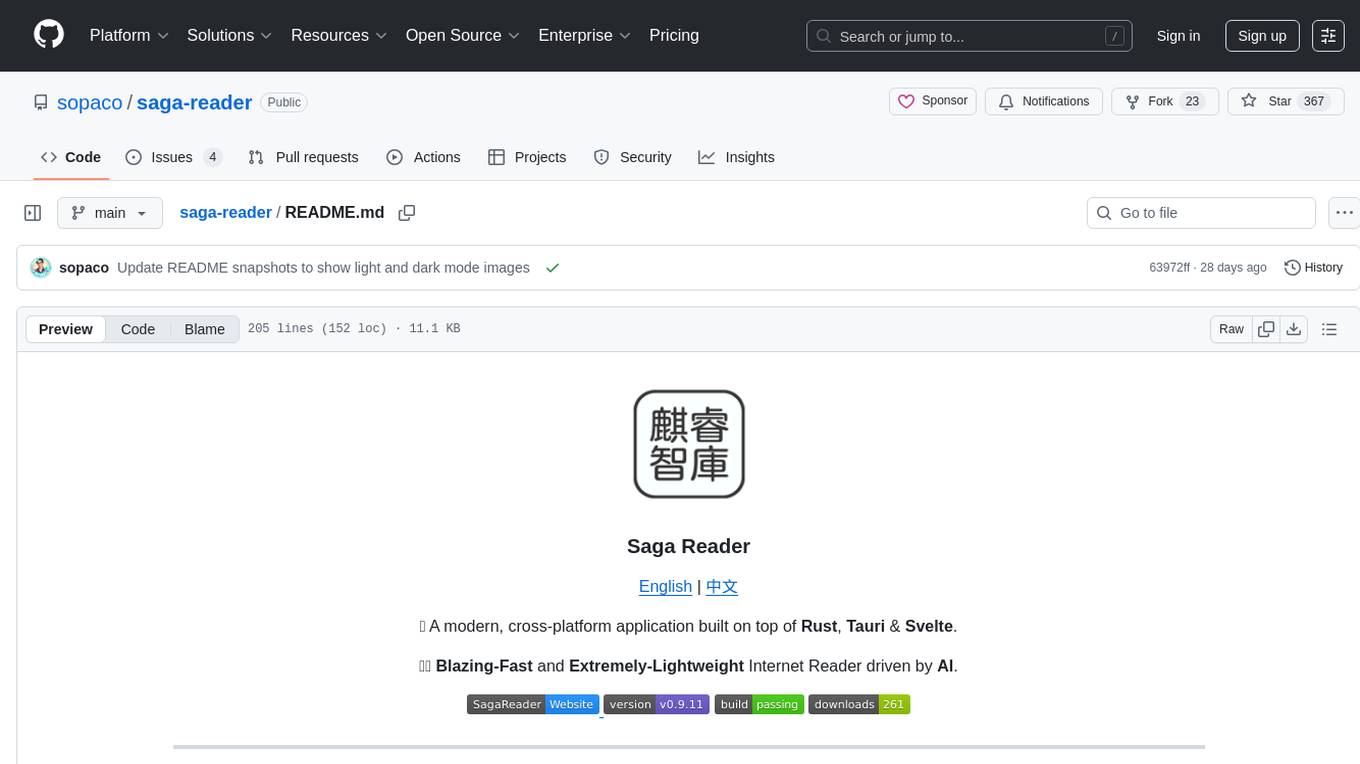
saga-reader
Saga Reader is an AI-driven think tank-style reader that automatically retrieves information from the internet based on user-specified topics and preferences. It uses cloud or local large models to summarize and provide guidance, and it includes an AI-driven interactive companion reading function, allowing you to discuss and exchange ideas with AI about the content you've read. Saga Reader is completely free and open-source, meaning all data is securely stored on your own computer and is not controlled by third-party service providers. Additionally, you can manage your subscription keywords based on your interests and preferences without being disturbed by advertisements and commercialized content.
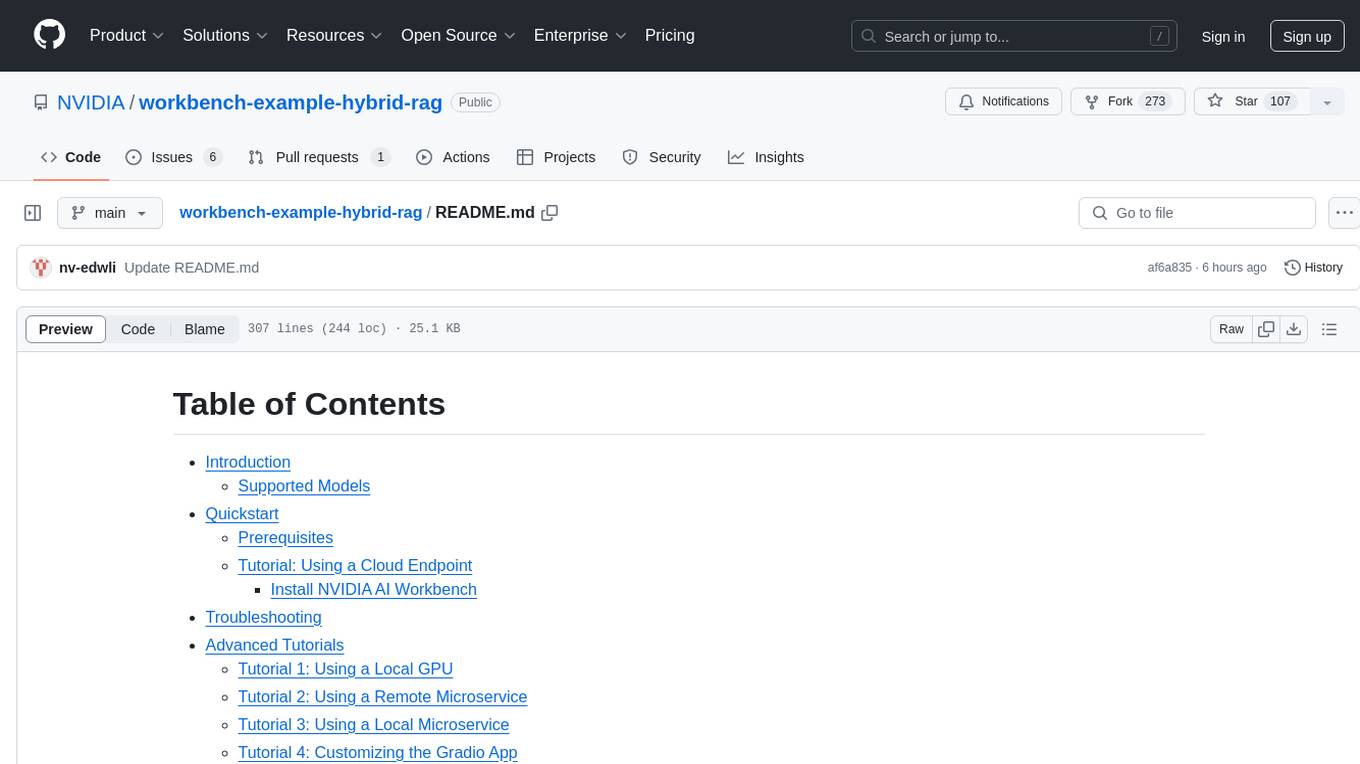
workbench-example-hybrid-rag
This NVIDIA AI Workbench project is designed for developing a Retrieval Augmented Generation application with a customizable Gradio Chat app. It allows users to embed documents into a locally running vector database and run inference locally on a Hugging Face TGI server, in the cloud using NVIDIA inference endpoints, or using microservices via NVIDIA Inference Microservices (NIMs). The project supports various models with different quantization options and provides tutorials for using different inference modes. Users can troubleshoot issues, customize the Gradio app, and access advanced tutorials for specific tasks.
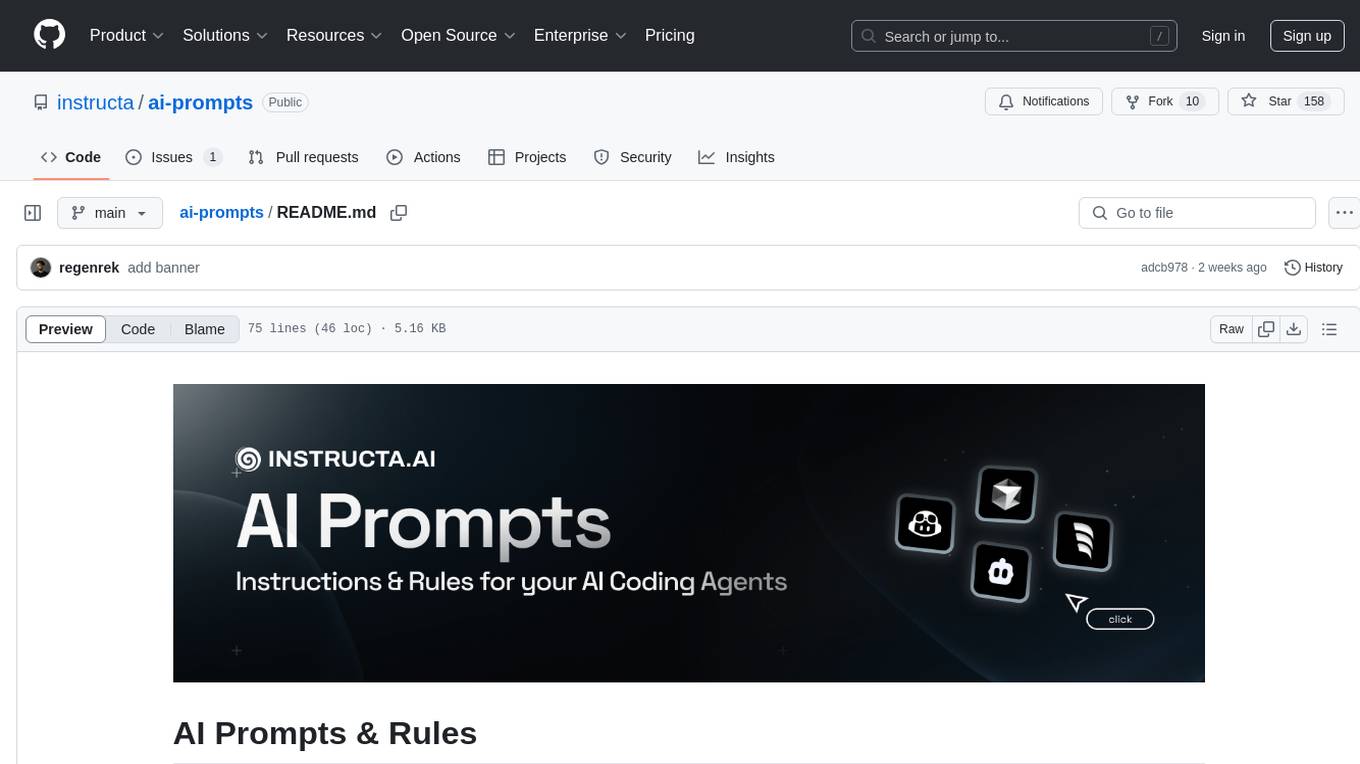
ai-prompts
Instructa AI Prompts is an open-source repository dedicated to collecting and sharing AI prompts, best practices, and curated rules for developers. The goal is to help users quickly set up and refine their workflow with ready-to-use prompts. Users can dynamically include prompts in AI-assisted coding tools like Cursor, GitHub Copilot, Zed, Windsurf, and Cline to adhere to project-specific coding standards, best practices, and automation workflows.
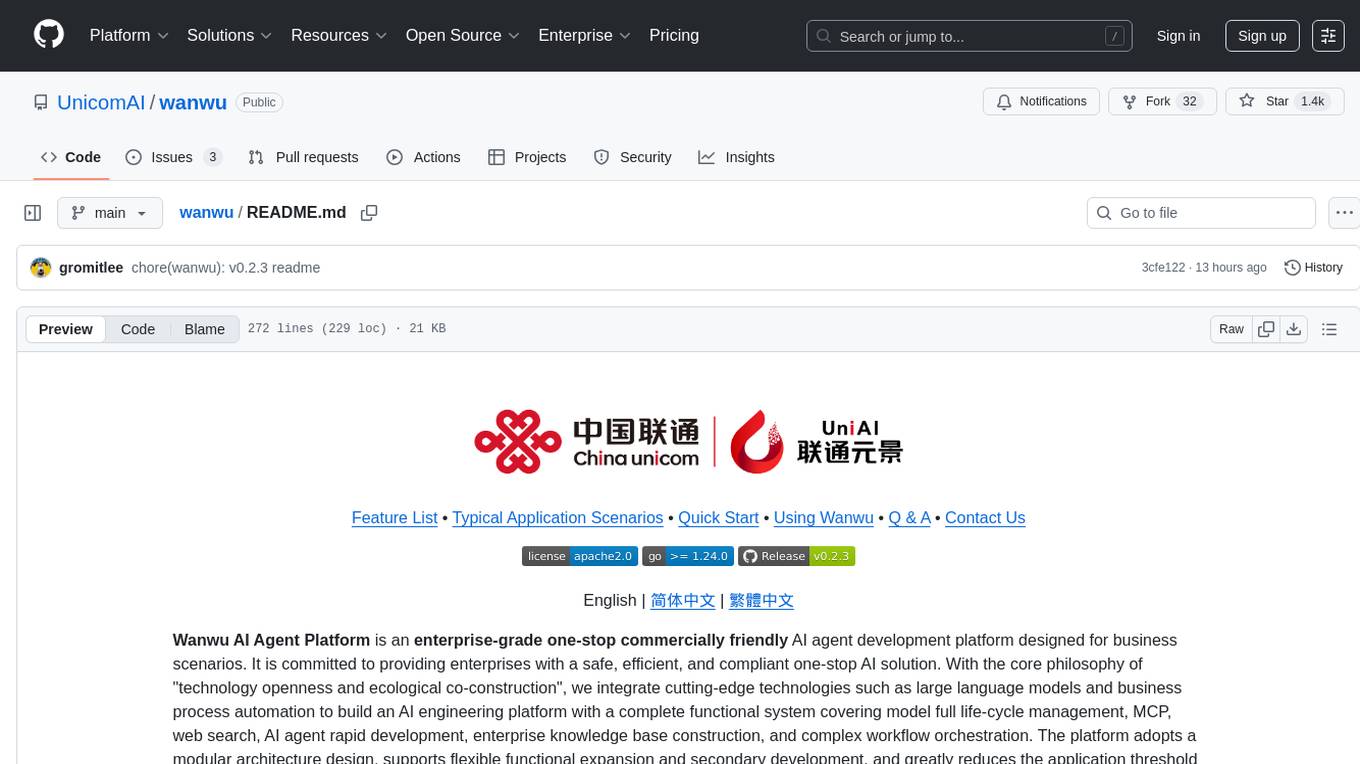
wanwu
Wanwu AI Agent Platform is an enterprise-grade one-stop commercially friendly AI agent development platform designed for business scenarios. It provides enterprises with a safe, efficient, and compliant one-stop AI solution. The platform integrates cutting-edge technologies such as large language models and business process automation to build an AI engineering platform covering model full life-cycle management, MCP, web search, AI agent rapid development, enterprise knowledge base construction, and complex workflow orchestration. It supports modular architecture design, flexible functional expansion, and secondary development, reducing the application threshold of AI technology while ensuring security and privacy protection of enterprise data. It accelerates digital transformation, cost reduction, efficiency improvement, and business innovation for enterprises of all sizes.
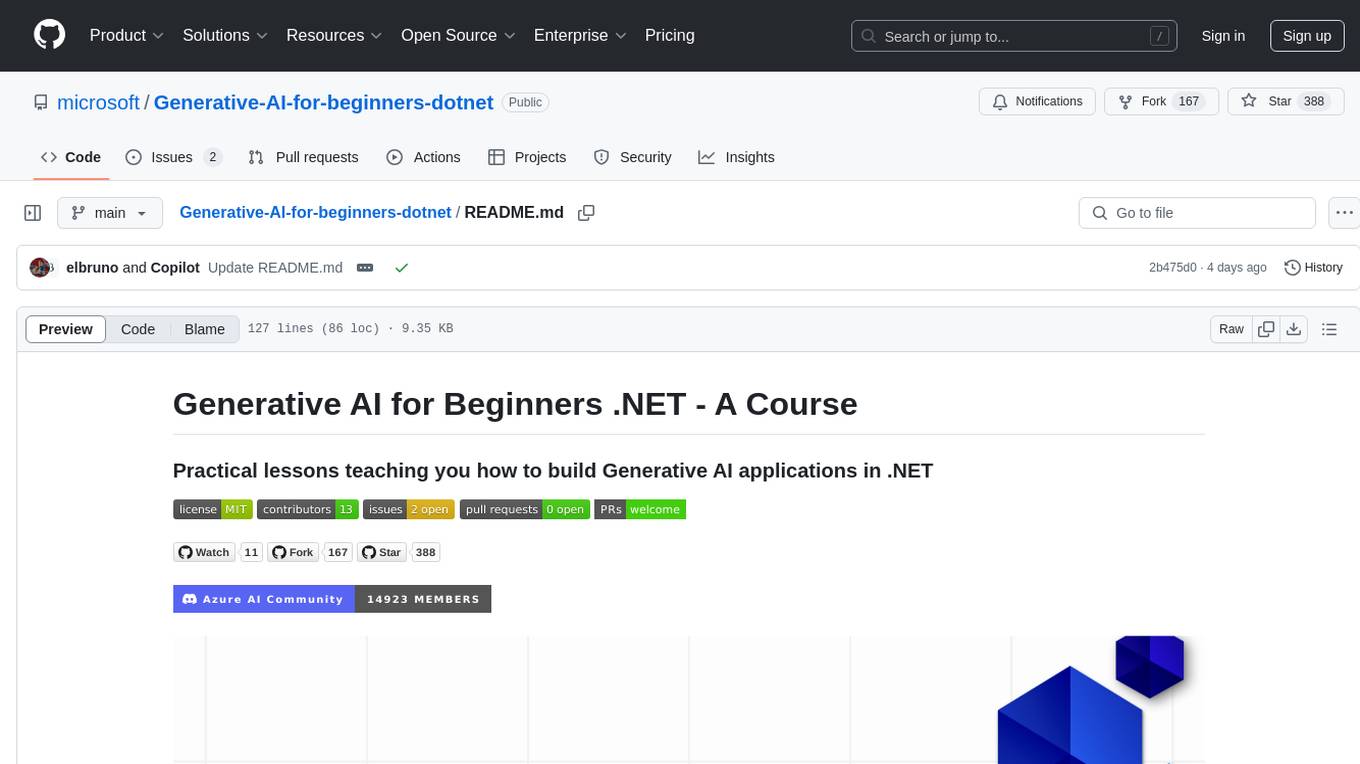
Generative-AI-for-beginners-dotnet
Generative AI for Beginners .NET is a hands-on course designed for .NET developers to learn how to build Generative AI applications. The repository focuses on real-world applications and live coding, providing fully functional code samples and integration with tools like GitHub Codespaces and GitHub Models. Lessons cover topics such as generative models, text generation, multimodal capabilities, and responsible use of Generative AI in .NET apps. The course aims to simplify the journey of implementing Generative AI into .NET projects, offering practical guidance and references for deeper theoretical understanding.
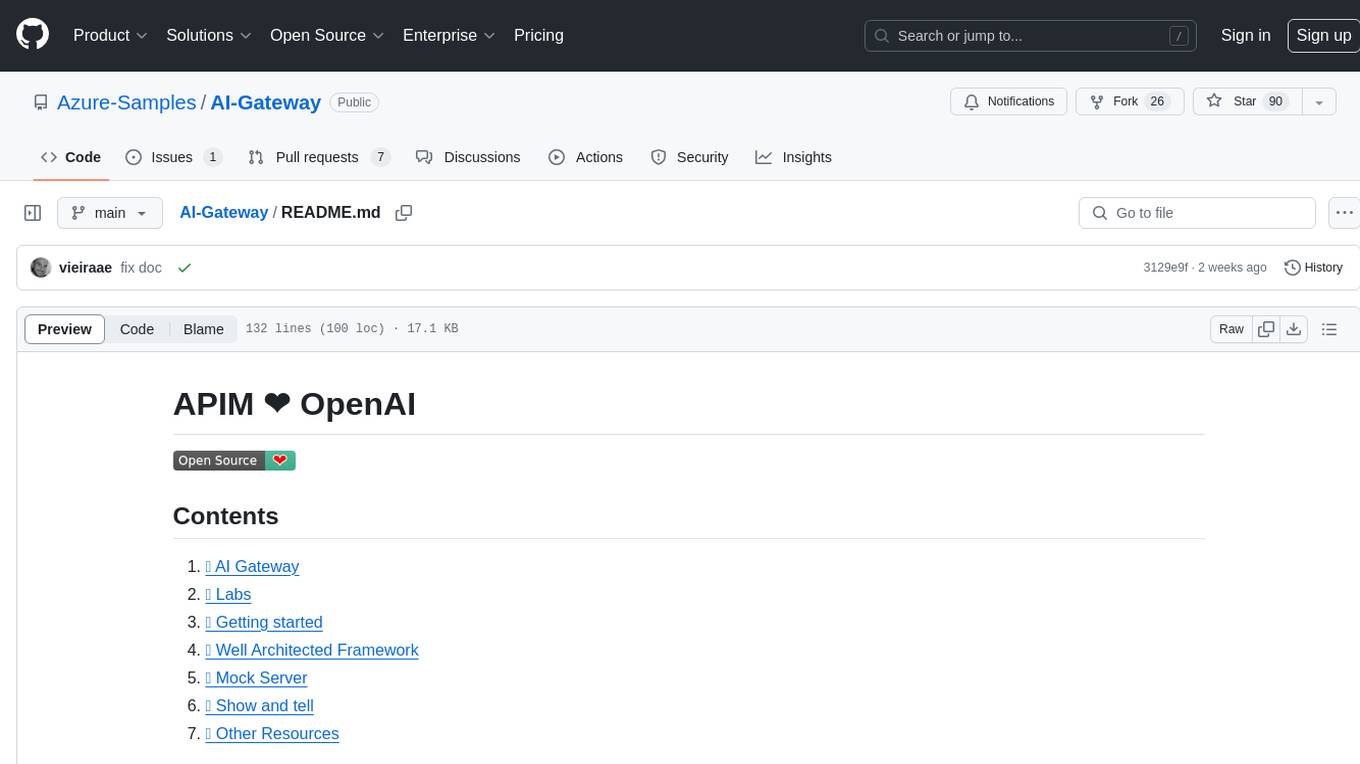
AI-Gateway
The AI-Gateway repository explores the AI Gateway pattern through a series of experimental labs, focusing on Azure API Management for handling AI services APIs. The labs provide step-by-step instructions using Jupyter notebooks with Python scripts, Bicep files, and APIM policies. The goal is to accelerate experimentation of advanced use cases and pave the way for further innovation in the rapidly evolving field of AI. The repository also includes a Mock Server to mimic the behavior of the OpenAI API for testing and development purposes.
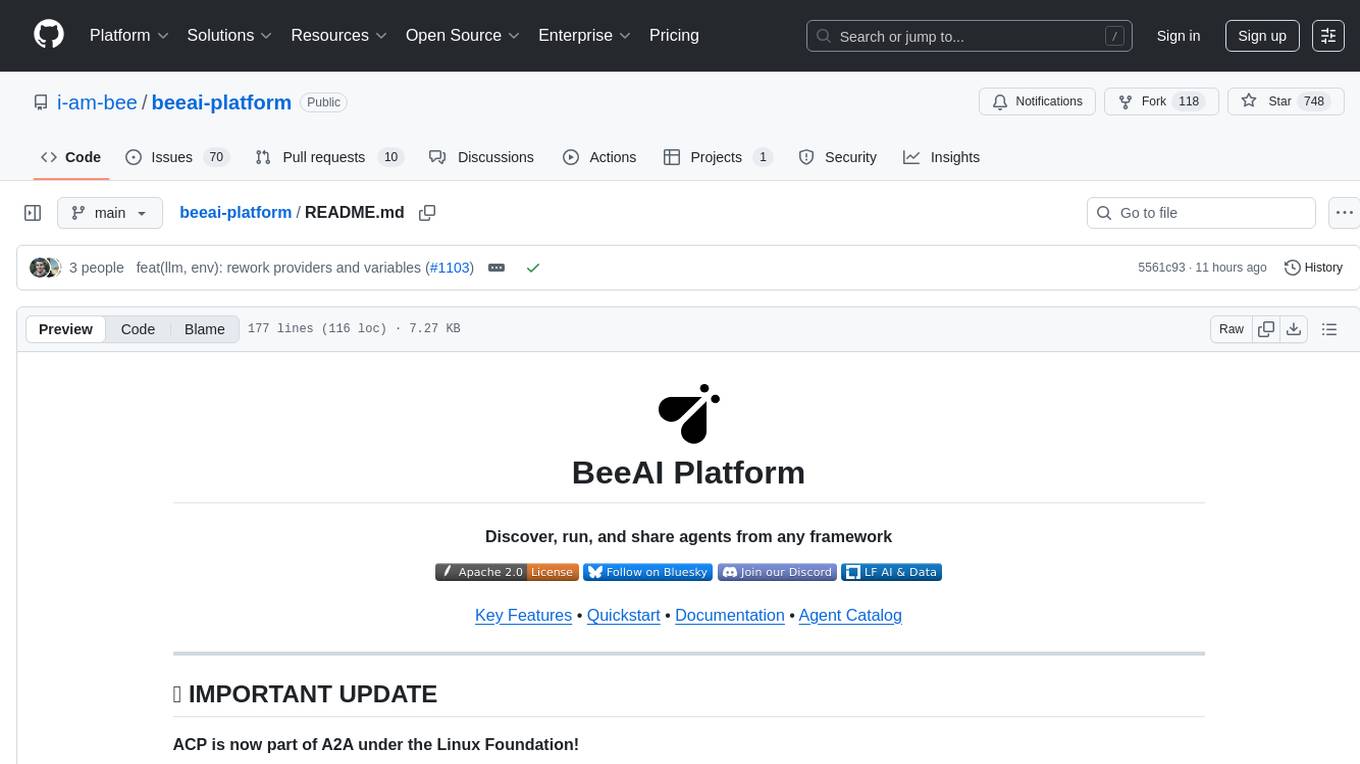
beeai-platform
BeeAI is an open-source platform that simplifies the discovery, running, and sharing of AI agents across different frameworks. It addresses challenges such as framework fragmentation, deployment complexity, and discovery issues by providing a standardized platform for individuals and teams to access agents easily. With features like a centralized agent catalog, framework-agnostic interfaces, containerized agents, and consistent user experiences, BeeAI aims to streamline the process of working with AI agents for both developers and teams.
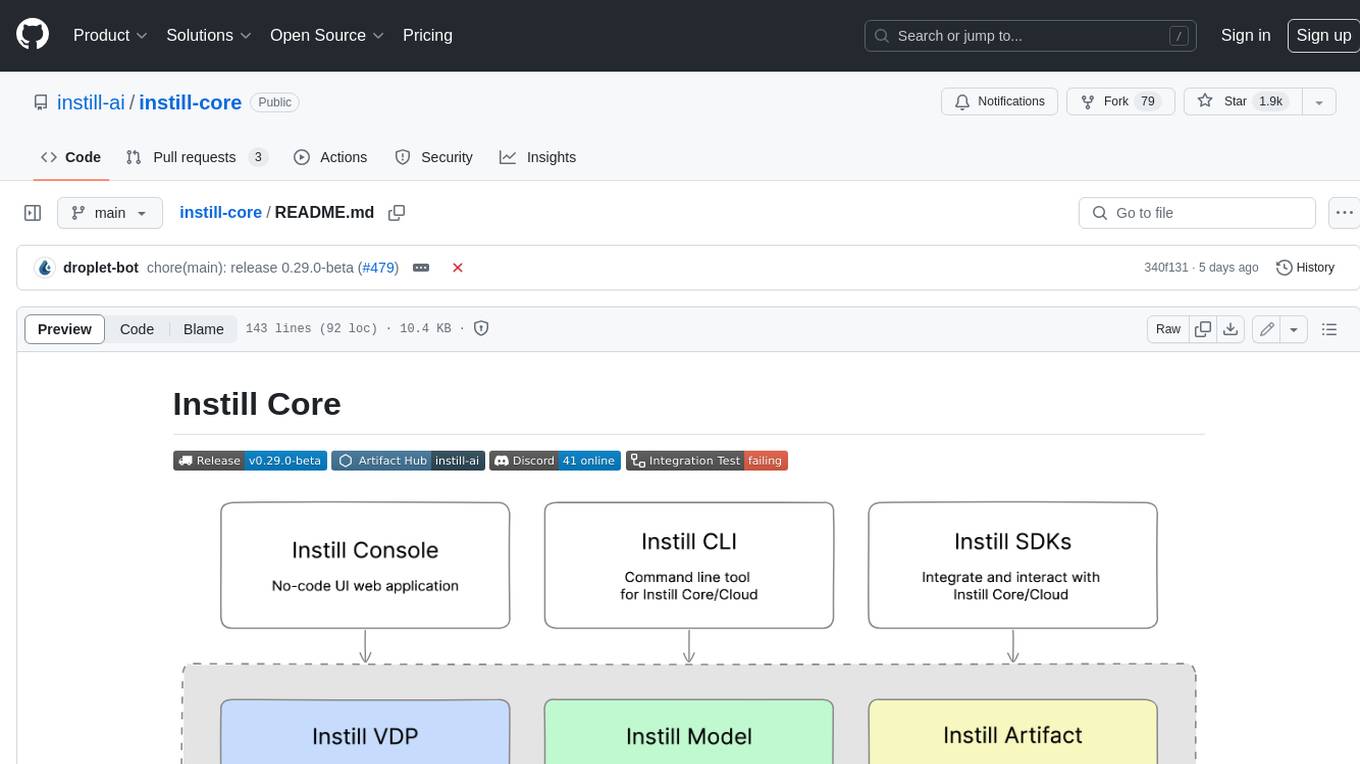
instill-core
Instill Core is an open-source orchestrator comprising a collection of source-available projects designed to streamline every aspect of building versatile AI features with unstructured data. It includes Instill VDP (Versatile Data Pipeline) for unstructured data, AI, and pipeline orchestration, Instill Model for scalable MLOps and LLMOps for open-source or custom AI models, and Instill Artifact for unified unstructured data management. Instill Core can be used for tasks such as building, testing, and sharing pipelines, importing, serving, fine-tuning, and monitoring ML models, and transforming documents, images, audio, and video into a unified AI-ready format.
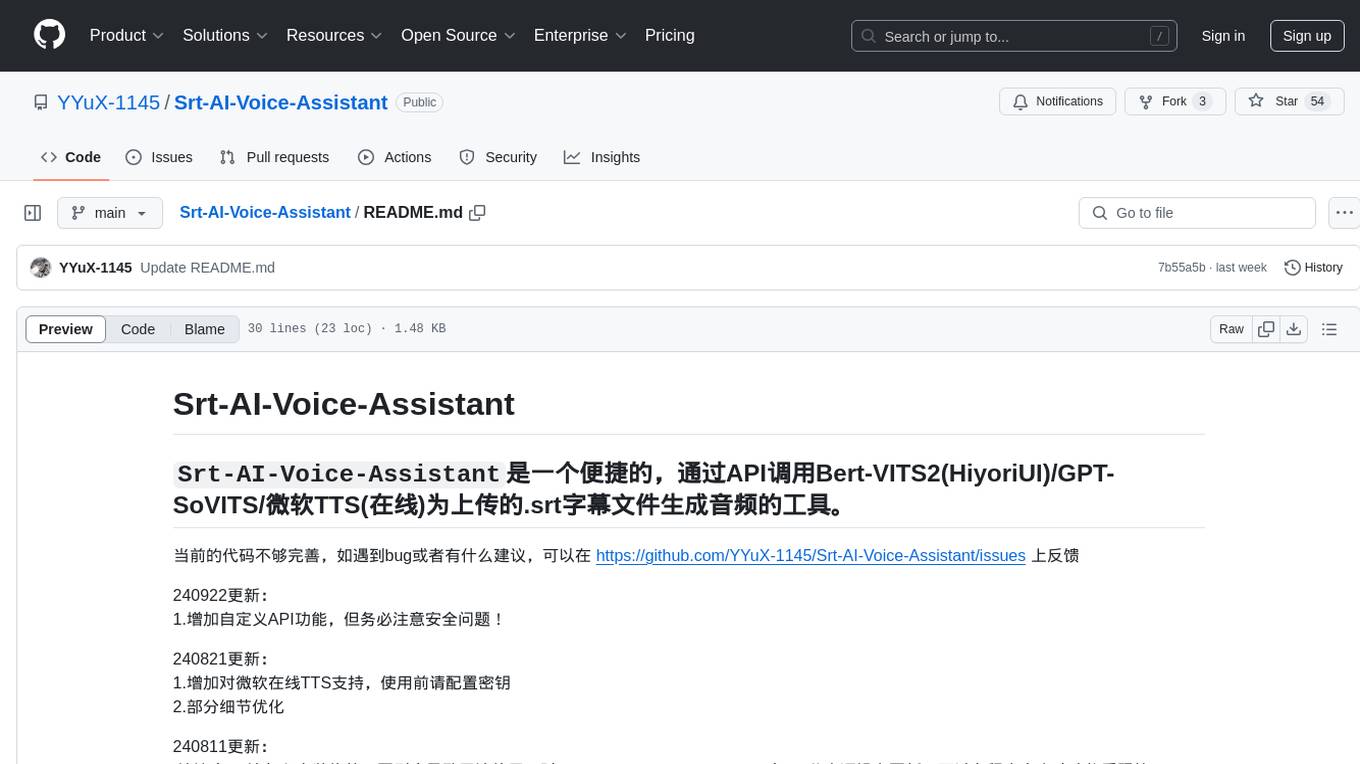
Srt-AI-Voice-Assistant
Srt-AI-Voice-Assistant is a convenient tool that generates audio from uploaded .srt subtitle files by calling APIs such as Bert-VITS2 (HiyoriUI), GPT-SoVITS, and Microsoft TTS (online). The code is currently not perfect, and feedback on bugs or suggestions can be provided at https://github.com/YYuX-1145/Srt-AI-Voice-Assistant/issues. Recent updates include adding custom API functionality with a focus on security, support for Microsoft online TTS (requires key configuration), error handling improvements, automatic project path detection, compatibility with API-v1 for limited functionality, and significant feature updates supporting card synthesis.
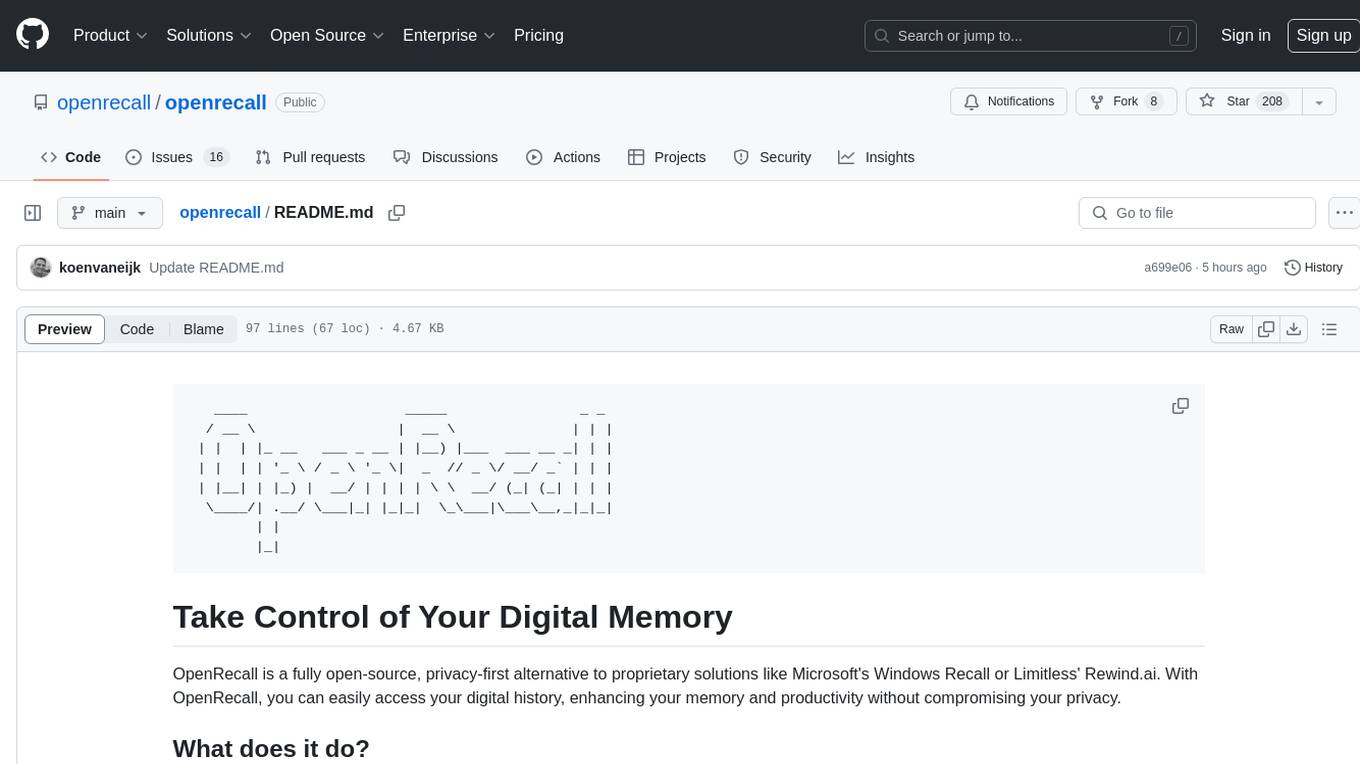
openrecall
OpenRecall is a fully open-source, privacy-first tool that captures your digital history through snapshots, making it searchable for quick access to specific information. It offers transparency, cross-platform support, privacy focus, and hardware compatibility. Features include time travel, local-first AI, semantic search, and full control over storage. The roadmap includes visual search capabilities and audio transcription. Users can easily install and run OpenRecall to enhance memory and productivity without compromising privacy.
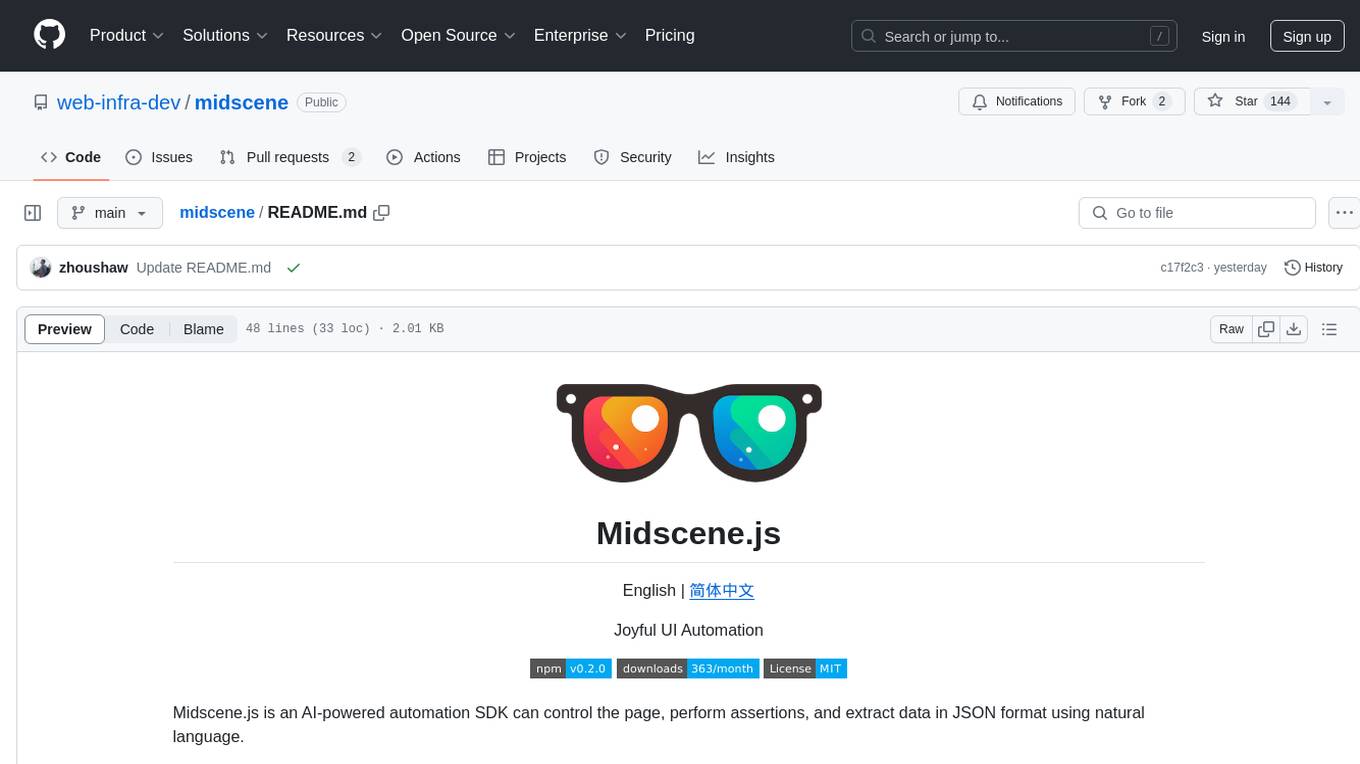
midscene
Midscene.js is an AI-powered automation SDK that allows users to control web pages, perform assertions, and extract data in JSON format using natural language. It offers features such as natural language interaction, understanding UI and providing responses in JSON, intuitive assertion based on AI understanding, compatibility with public multimodal LLMs like GPT-4o, visualization tool for easy debugging, and a brand new experience in automation development.
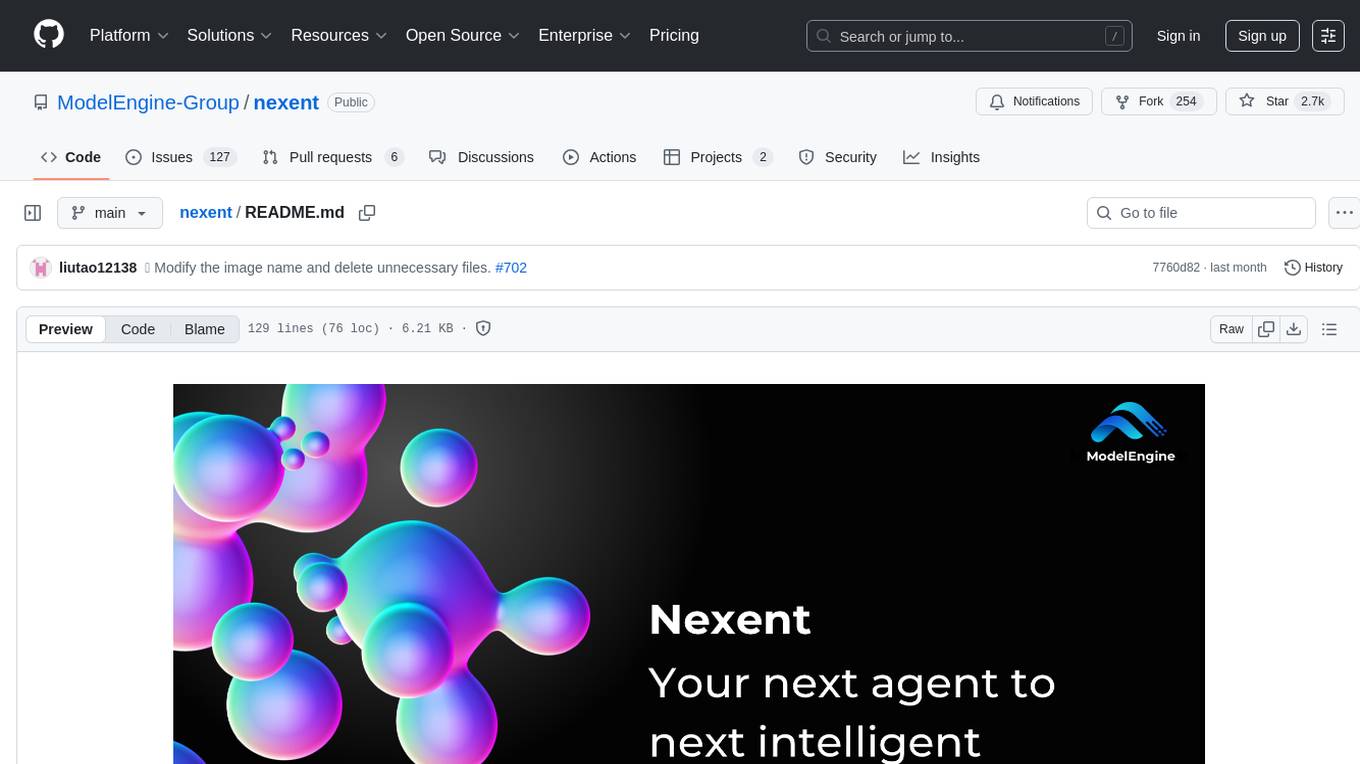
nexent
Nexent is a powerful tool for analyzing and visualizing network traffic data. It provides comprehensive insights into network behavior, helping users to identify patterns, anomalies, and potential security threats. With its user-friendly interface and advanced features, Nexent is suitable for network administrators, cybersecurity professionals, and anyone looking to gain a deeper understanding of their network infrastructure.

mattermost-plugin-agents
The Mattermost Agents Plugin integrates AI capabilities directly into your Mattermost workspace, allowing users to run local LLMs on their infrastructure or connect to cloud providers. It offers multiple AI assistants with specialized personalities, thread and channel summarization, action item extraction, meeting transcription, semantic search, smart reactions, direct conversations with AI assistants, and flexible LLM support. The plugin comes with comprehensive documentation, installation instructions, system requirements, and development guidelines for users to interact with AI features and configure LLM providers.
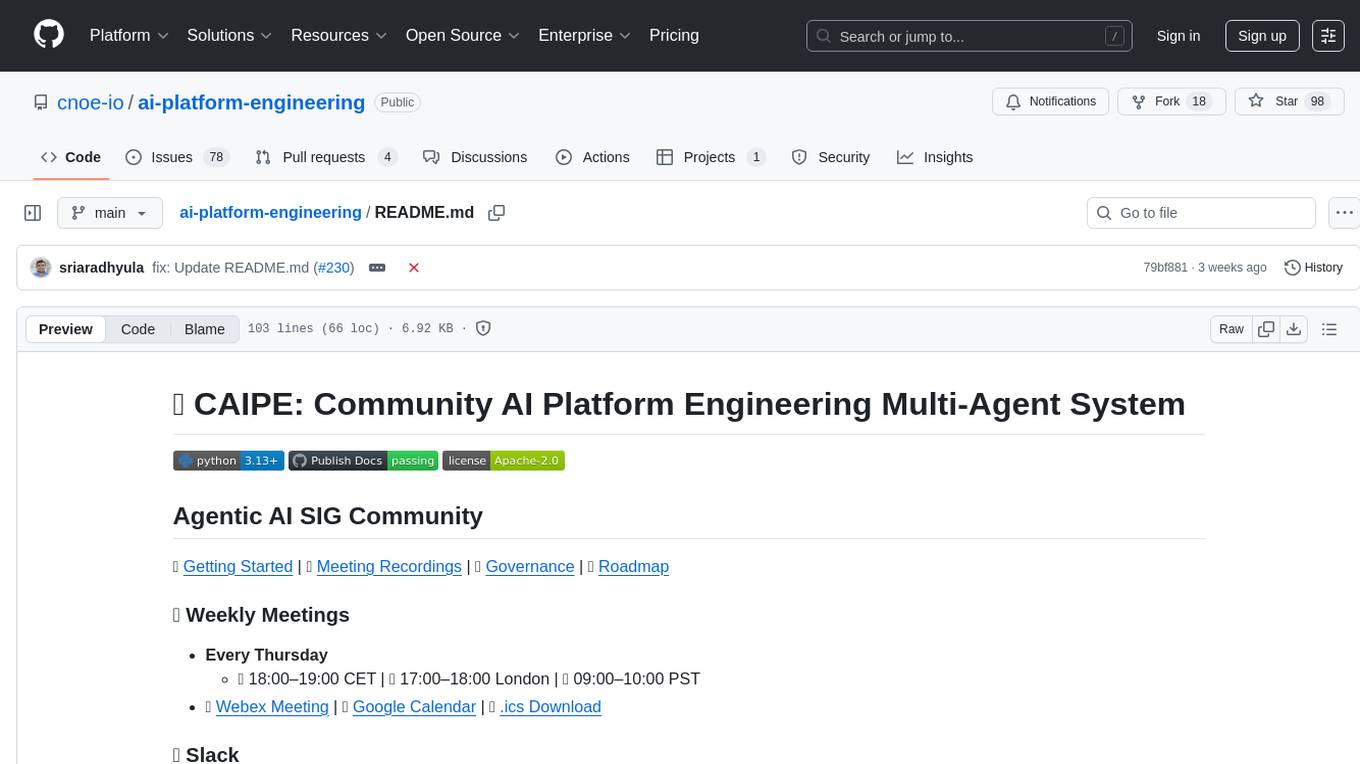
ai-platform-engineering
The AI Platform Engineering repository provides a collection of tools and resources for building and deploying AI models. It includes libraries for data preprocessing, model training, and model serving. The repository also contains example code and tutorials to help users get started with AI development. Whether you are a beginner or an experienced AI engineer, this repository offers valuable insights and best practices to streamline your AI projects.
For similar tasks

llm-twin-course
The LLM Twin Course is a free, end-to-end framework for building production-ready LLM systems. It teaches you how to design, train, and deploy a production-ready LLM twin of yourself powered by LLMs, vector DBs, and LLMOps good practices. The course is split into 11 hands-on written lessons and the open-source code you can access on GitHub. You can read everything and try out the code at your own pace.

Agent
Agent is a RustSBI specialized domain knowledge quiz LLM tool that extracts domain knowledge from various sources such as Rust Documentation, RISC-V Documentation, Bouffalo Docs, Bouffalo SDK, and Xiangshan Docs. It also provides resources for LLM prompt engineering and RAG engineering, including guides and existing projects related to retrieval-augmented generation (RAG) systems.
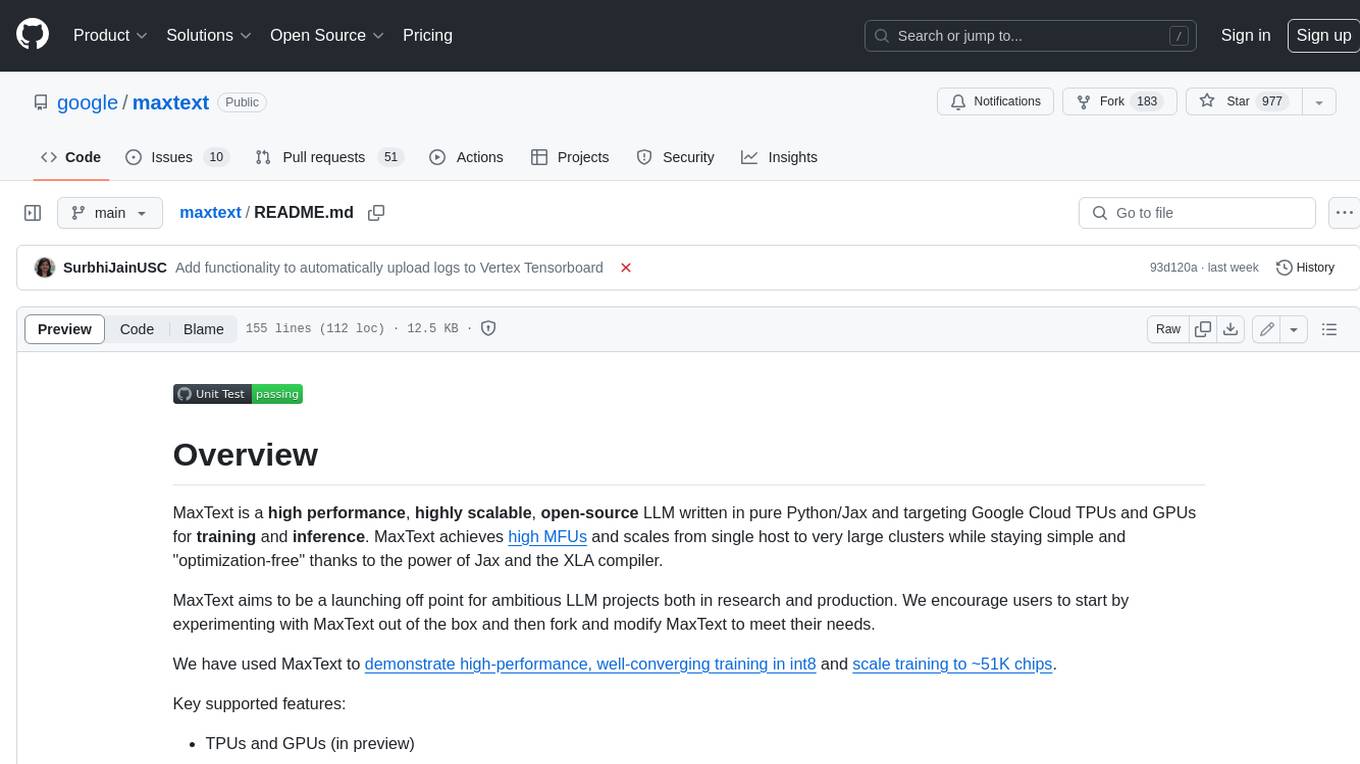
maxtext
MaxText is a high-performance, highly scalable, open-source LLM written in pure Python/Jax and targeting Google Cloud TPUs and GPUs for training and inference. MaxText achieves high MFUs and scales from single host to very large clusters while staying simple and "optimization-free" thanks to the power of Jax and the XLA compiler. MaxText aims to be a launching off point for ambitious LLM projects both in research and production. We encourage users to start by experimenting with MaxText out of the box and then fork and modify MaxText to meet their needs.
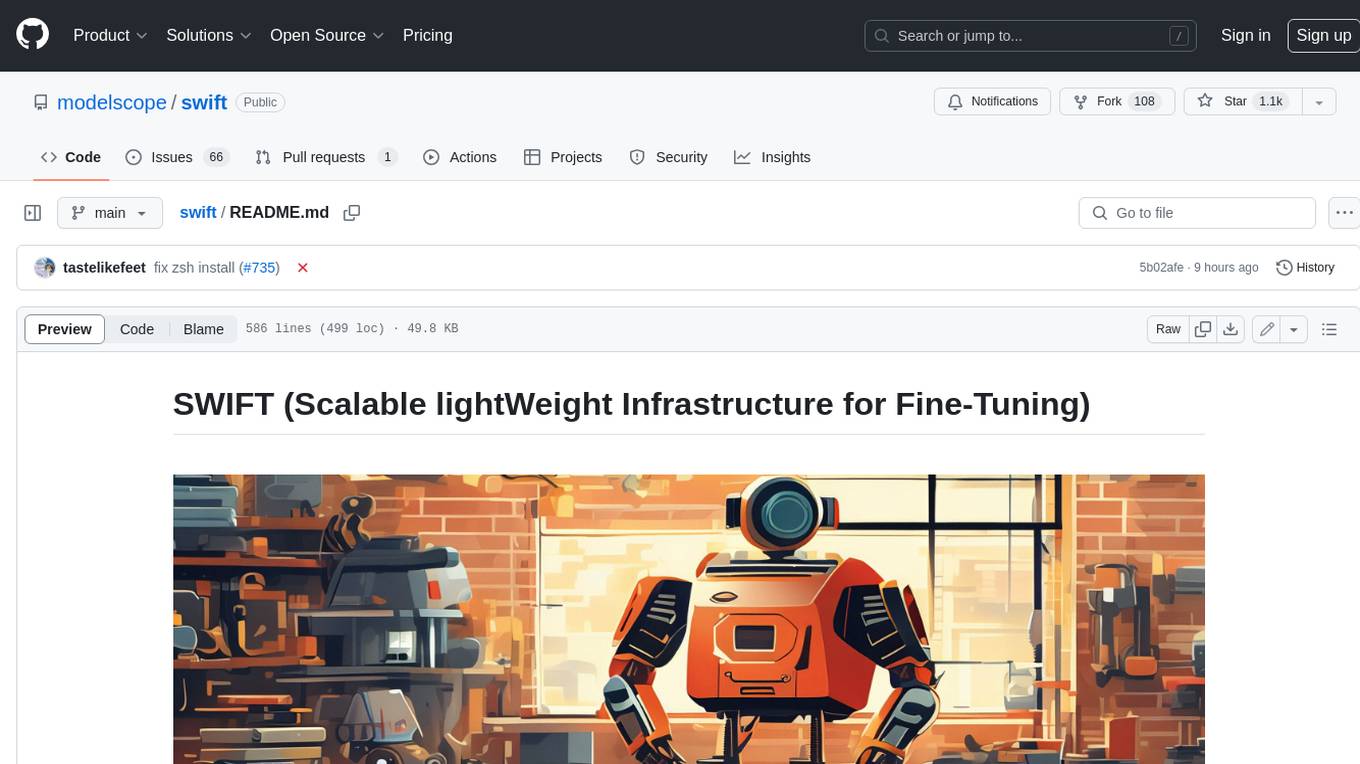
swift
SWIFT (Scalable lightWeight Infrastructure for Fine-Tuning) supports training, inference, evaluation and deployment of nearly **200 LLMs and MLLMs** (multimodal large models). Developers can directly apply our framework to their own research and production environments to realize the complete workflow from model training and evaluation to application. In addition to supporting the lightweight training solutions provided by [PEFT](https://github.com/huggingface/peft), we also provide a complete **Adapters library** to support the latest training techniques such as NEFTune, LoRA+, LLaMA-PRO, etc. This adapter library can be used directly in your own custom workflow without our training scripts. To facilitate use by users unfamiliar with deep learning, we provide a Gradio web-ui for controlling training and inference, as well as accompanying deep learning courses and best practices for beginners. Additionally, we are expanding capabilities for other modalities. Currently, we support full-parameter training and LoRA training for AnimateDiff.
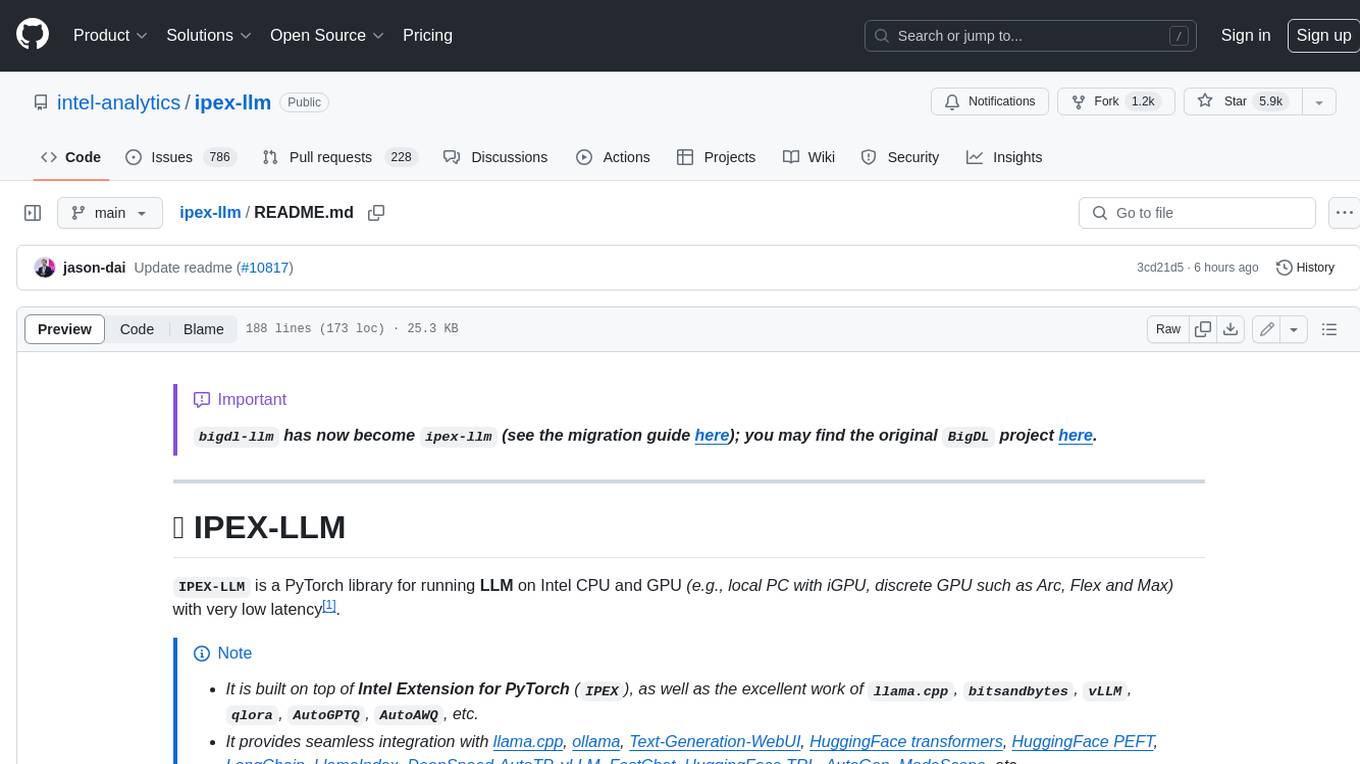
ipex-llm
IPEX-LLM is a PyTorch library for running Large Language Models (LLMs) on Intel CPUs and GPUs with very low latency. It provides seamless integration with various LLM frameworks and tools, including llama.cpp, ollama, Text-Generation-WebUI, HuggingFace transformers, and more. IPEX-LLM has been optimized and verified on over 50 LLM models, including LLaMA, Mistral, Mixtral, Gemma, LLaVA, Whisper, ChatGLM, Baichuan, Qwen, and RWKV. It supports a range of low-bit inference formats, including INT4, FP8, FP4, INT8, INT2, FP16, and BF16, as well as finetuning capabilities for LoRA, QLoRA, DPO, QA-LoRA, and ReLoRA. IPEX-LLM is actively maintained and updated with new features and optimizations, making it a valuable tool for researchers, developers, and anyone interested in exploring and utilizing LLMs.
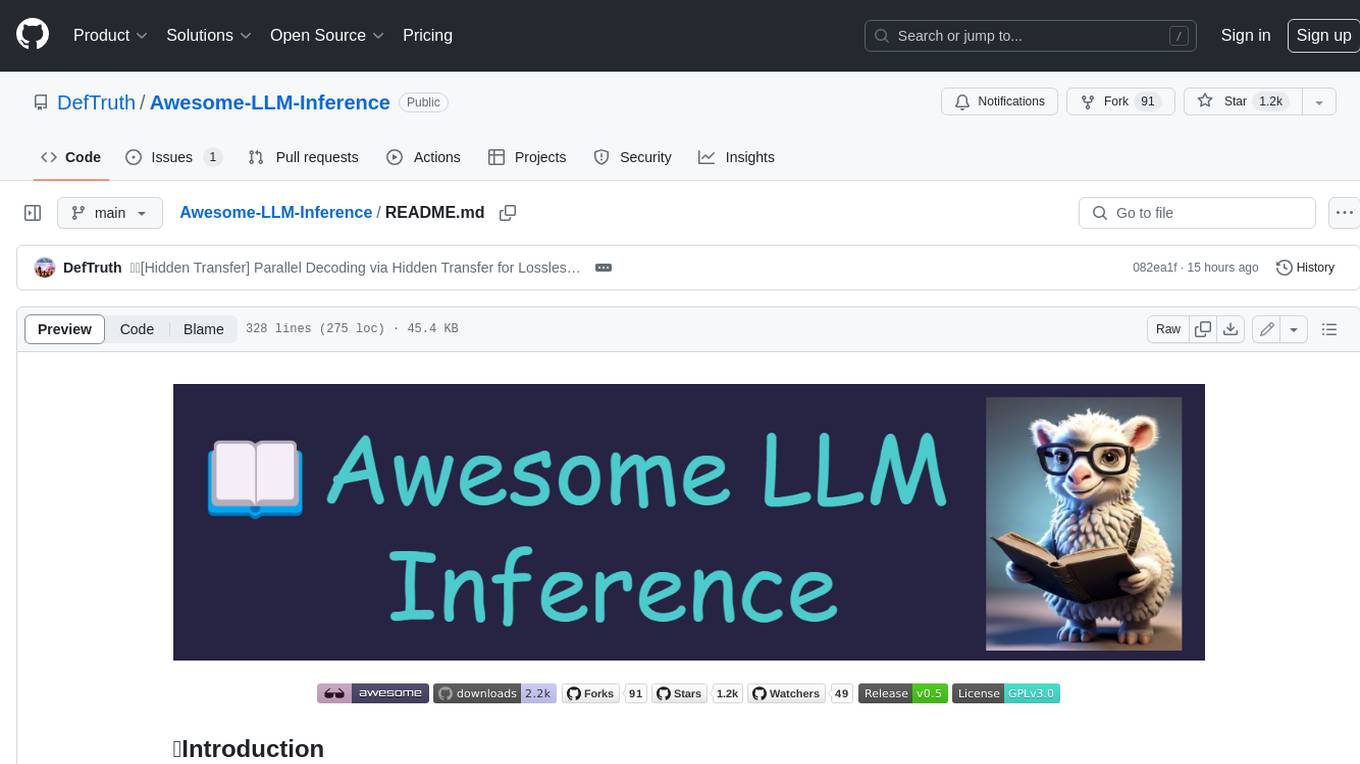
Awesome-LLM-Inference
Awesome-LLM-Inference: A curated list of 📙Awesome LLM Inference Papers with Codes, check 📖Contents for more details. This repo is still updated frequently ~ 👨💻 Welcome to star ⭐️ or submit a PR to this repo!
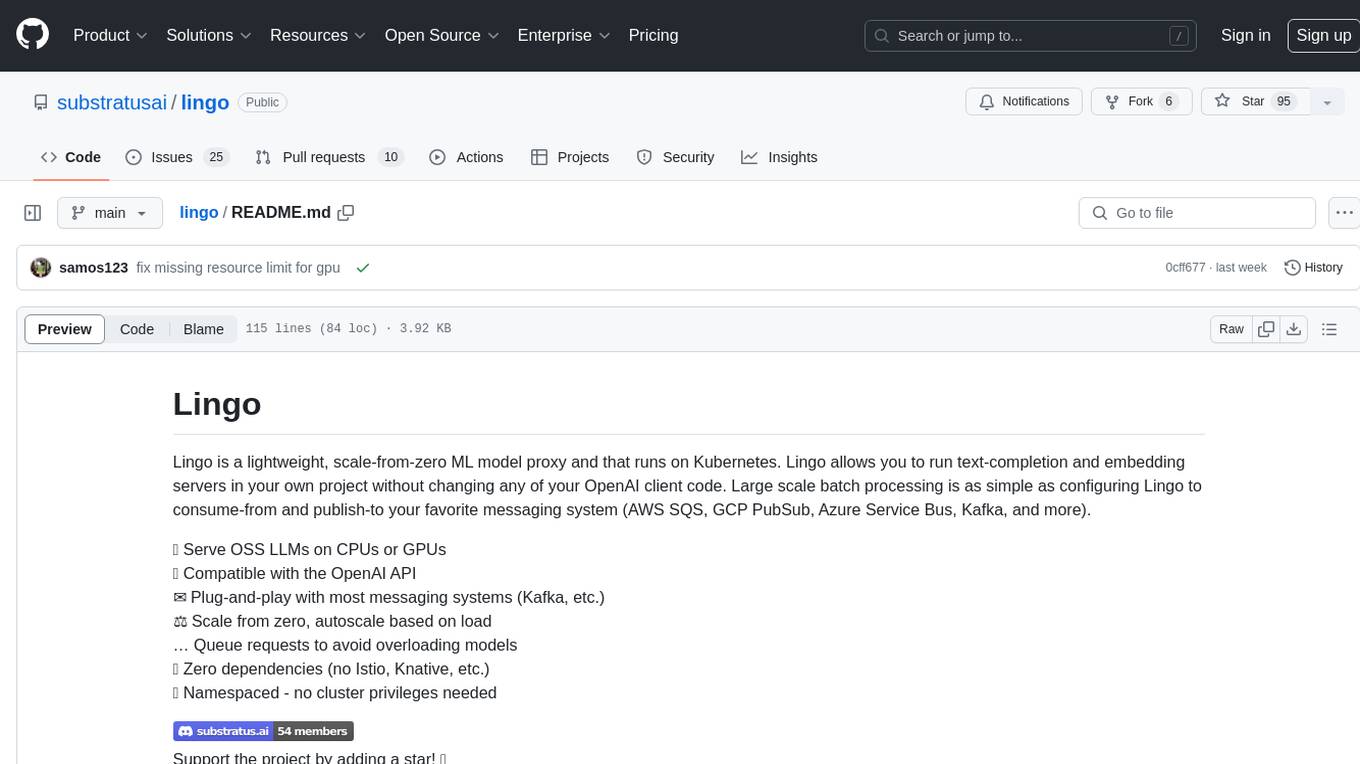
lingo
Lingo is a lightweight ML model proxy that runs on Kubernetes, allowing you to run text-completion and embedding servers without changing OpenAI client code. It supports serving OSS LLMs, is compatible with OpenAI API, plug-and-play with messaging systems, scales from zero based on load, and has zero dependencies. Namespaced with no cluster privileges needed.
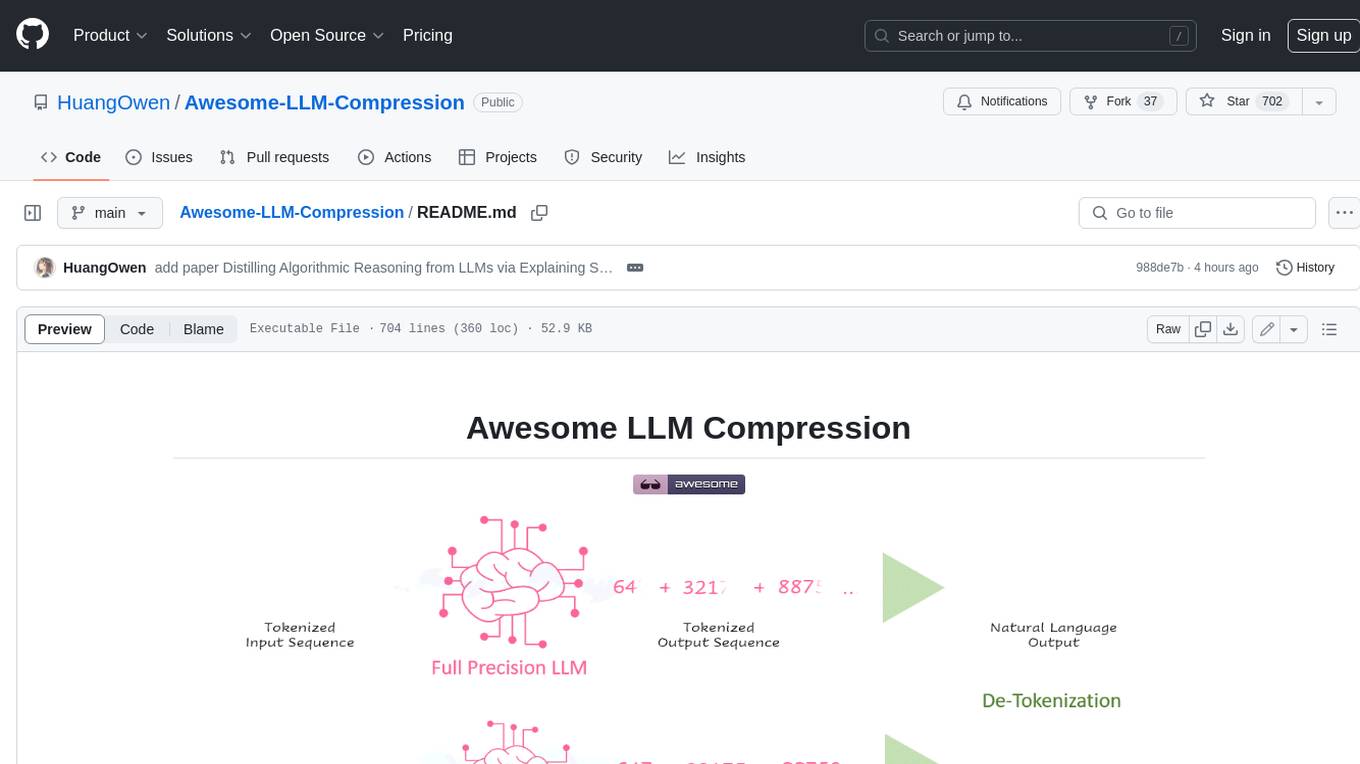
Awesome-LLM-Compression
Awesome LLM compression research papers and tools to accelerate LLM training and inference.
For similar jobs
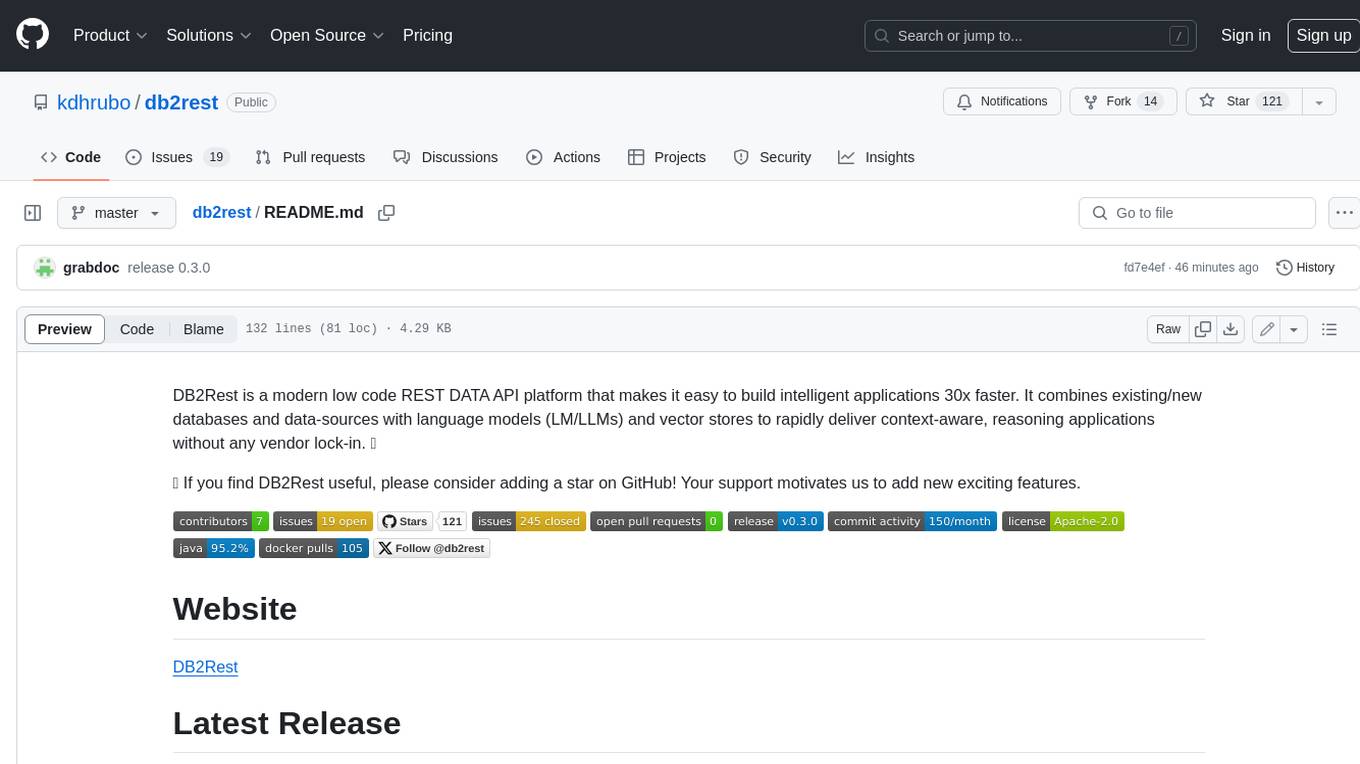
db2rest
DB2Rest is a modern low-code REST DATA API platform that simplifies the development of intelligent applications. It seamlessly integrates existing and new databases with language models (LMs/LLMs) and vector stores, enabling the rapid delivery of context-aware, reasoning applications without vendor lock-in.

mage-ai
Mage is an open-source data pipeline tool for transforming and integrating data. It offers an easy developer experience, engineering best practices built-in, and data as a first-class citizen. Mage makes it easy to build, preview, and launch data pipelines, and provides observability and scaling capabilities. It supports data integrations, streaming pipelines, and dbt integration.
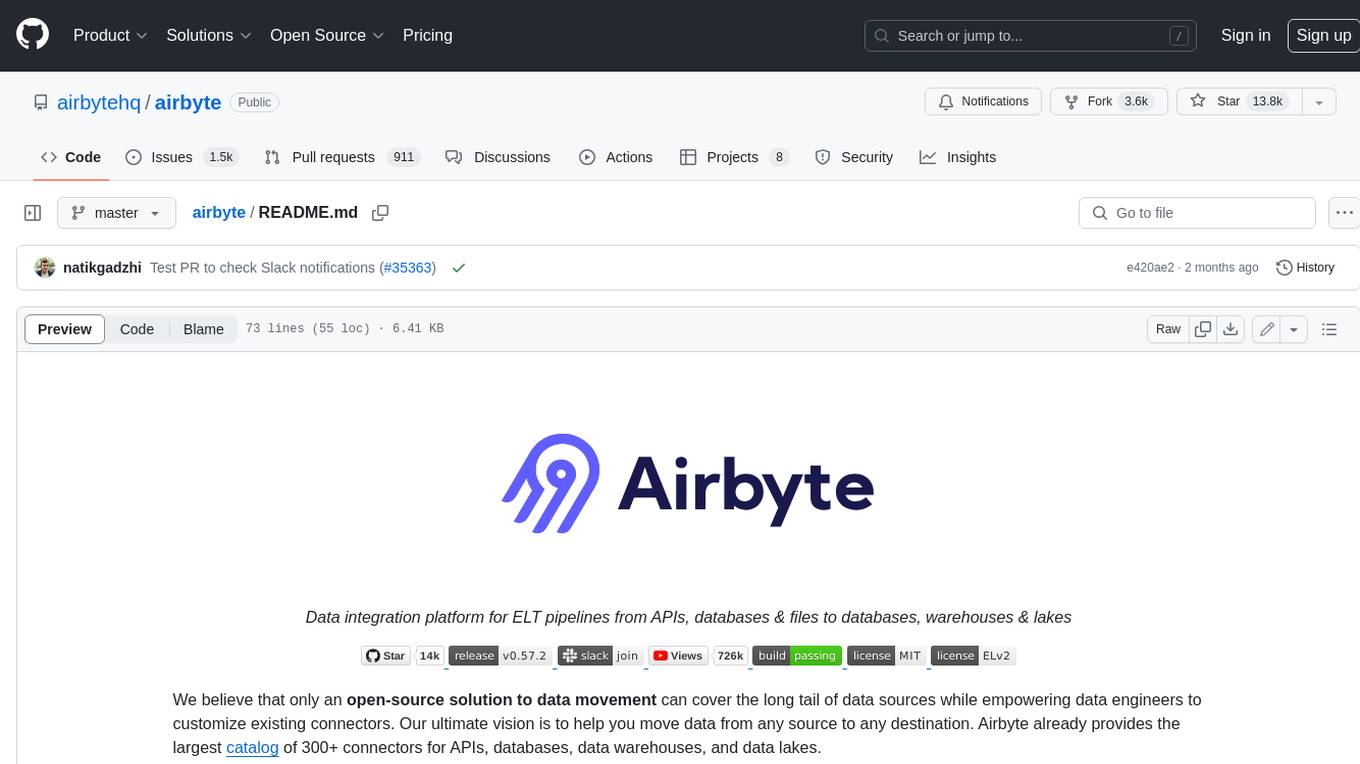
airbyte
Airbyte is an open-source data integration platform that makes it easy to move data from any source to any destination. With Airbyte, you can build and manage data pipelines without writing any code. Airbyte provides a library of pre-built connectors that make it easy to connect to popular data sources and destinations. You can also create your own connectors using Airbyte's no-code Connector Builder or low-code CDK. Airbyte is used by data engineers and analysts at companies of all sizes to build and manage their data pipelines.
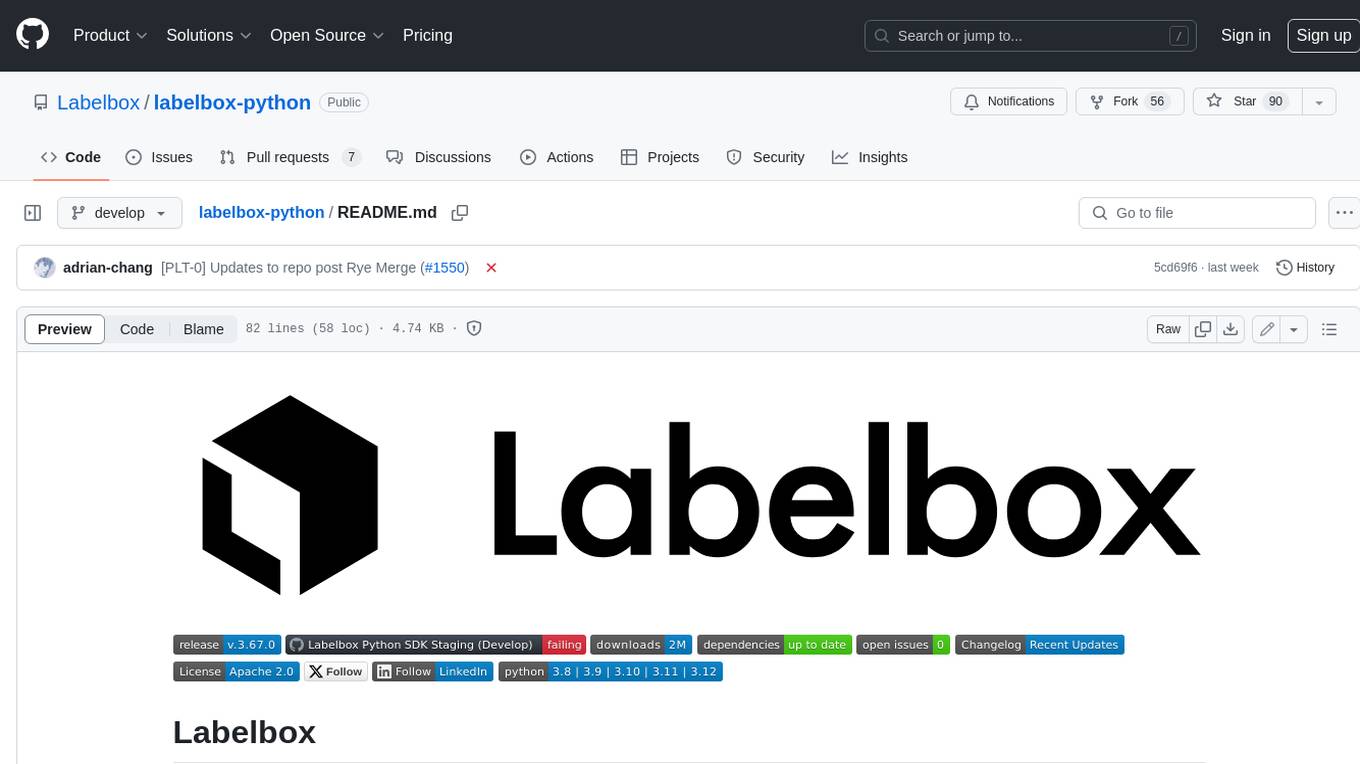
labelbox-python
Labelbox is a data-centric AI platform for enterprises to develop, optimize, and use AI to solve problems and power new products and services. Enterprises use Labelbox to curate data, generate high-quality human feedback data for computer vision and LLMs, evaluate model performance, and automate tasks by combining AI and human-centric workflows. The academic & research community uses Labelbox for cutting-edge AI research.
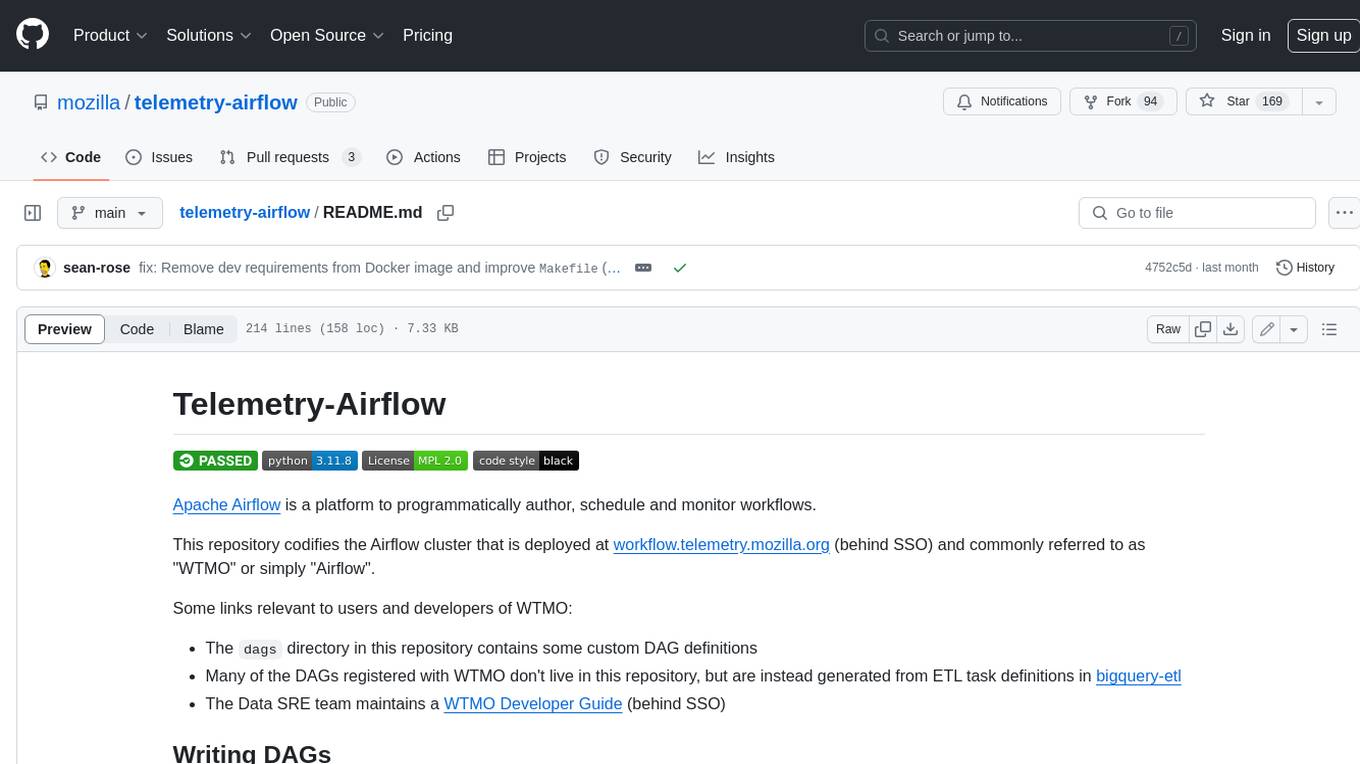
telemetry-airflow
This repository codifies the Airflow cluster that is deployed at workflow.telemetry.mozilla.org (behind SSO) and commonly referred to as "WTMO" or simply "Airflow". Some links relevant to users and developers of WTMO: * The `dags` directory in this repository contains some custom DAG definitions * Many of the DAGs registered with WTMO don't live in this repository, but are instead generated from ETL task definitions in bigquery-etl * The Data SRE team maintains a WTMO Developer Guide (behind SSO)
airflow
Apache Airflow (or simply Airflow) is a platform to programmatically author, schedule, and monitor workflows. When workflows are defined as code, they become more maintainable, versionable, testable, and collaborative. Use Airflow to author workflows as directed acyclic graphs (DAGs) of tasks. The Airflow scheduler executes your tasks on an array of workers while following the specified dependencies. Rich command line utilities make performing complex surgeries on DAGs a snap. The rich user interface makes it easy to visualize pipelines running in production, monitor progress, and troubleshoot issues when needed.

airbyte-platform
Airbyte is an open-source data integration platform that makes it easy to move data from any source to any destination. With Airbyte, you can build and manage data pipelines without writing any code. Airbyte provides a library of pre-built connectors that make it easy to connect to popular data sources and destinations. You can also create your own connectors using Airbyte's low-code Connector Development Kit (CDK). Airbyte is used by data engineers and analysts at companies of all sizes to move data for a variety of purposes, including data warehousing, data analysis, and machine learning.
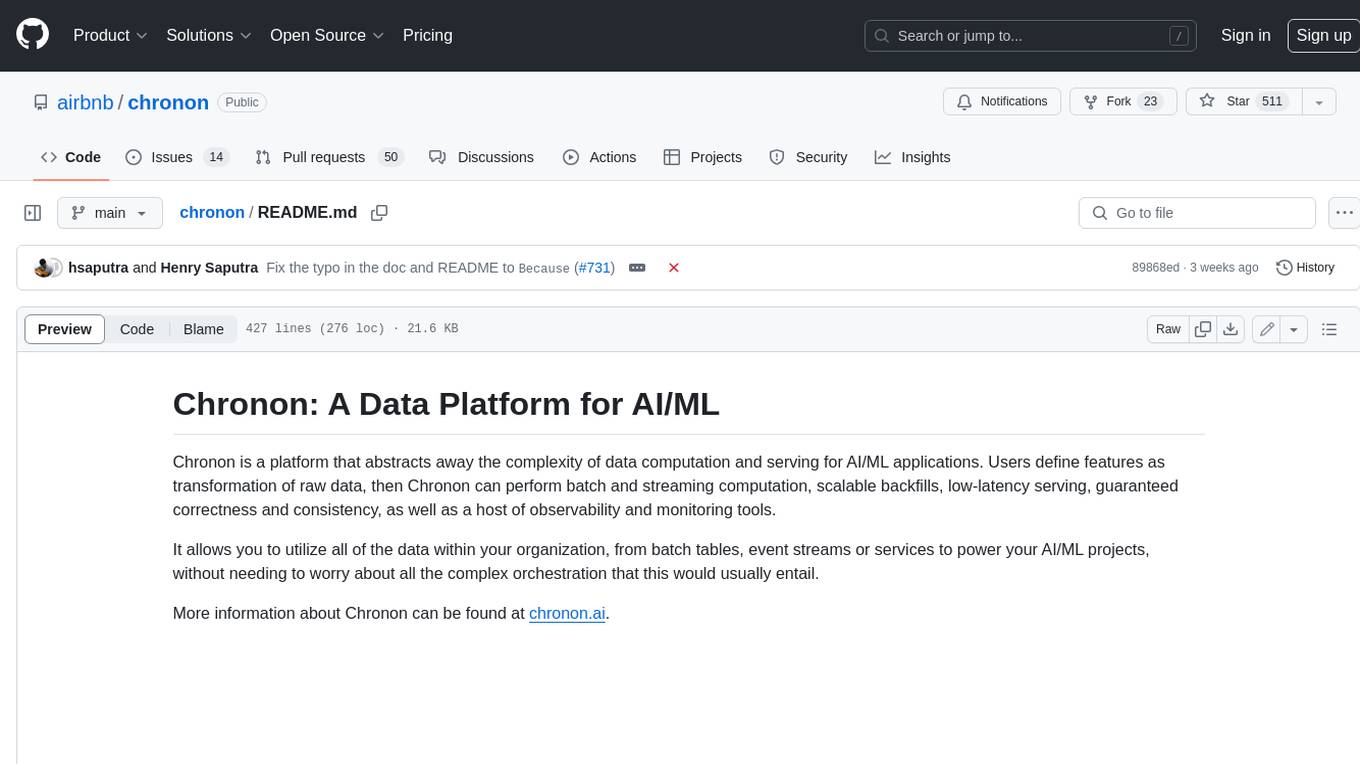
chronon
Chronon is a platform that simplifies and improves ML workflows by providing a central place to define features, ensuring point-in-time correctness for backfills, simplifying orchestration for batch and streaming pipelines, offering easy endpoints for feature fetching, and guaranteeing and measuring consistency. It offers benefits over other approaches by enabling the use of a broad set of data for training, handling large aggregations and other computationally intensive transformations, and abstracting away the infrastructure complexity of data plumbing.



